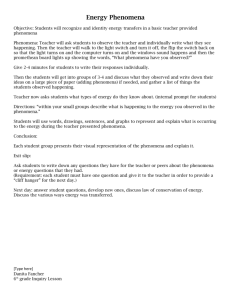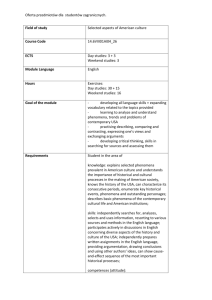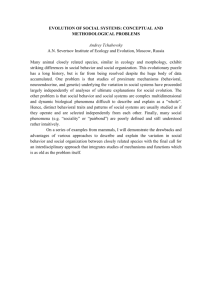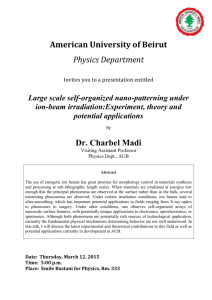BP08 L19 (F&A) - Amitabha Buddhist Centre
advertisement
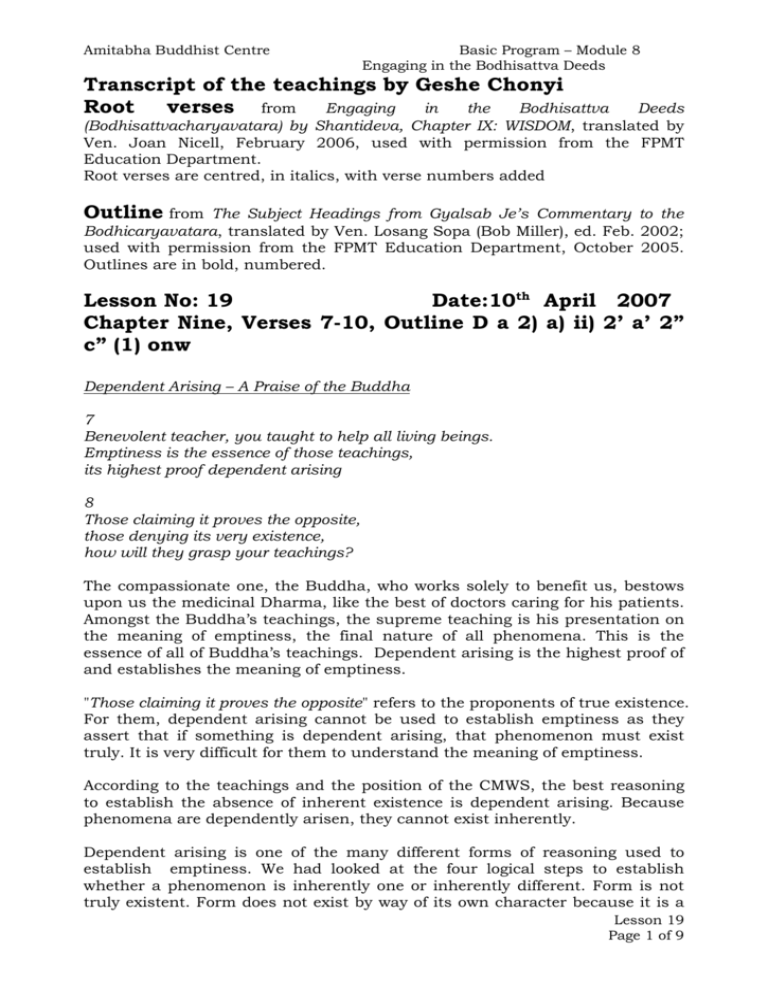
Amitabha Buddhist Centre Basic Program – Module 8 Engaging in the Bodhisattva Deeds Transcript of the teachings by Geshe Chonyi Root verses from Engaging in the Bodhisattva Deeds (Bodhisattvacharyavatara) by Shantideva, Chapter IX: WISDOM, translated by Ven. Joan Nicell, February 2006, used with permission from the FPMT Education Department. Root verses are centred, in italics, with verse numbers added Outline from The Subject Headings from Gyalsab Je’s Commentary to the Bodhicaryavatara, translated by Ven. Losang Sopa (Bob Miller), ed. Feb. 2002; used with permission from the FPMT Education Department, October 2005. Outlines are in bold, numbered. Lesson No: 19 Date:10th April 2007 Chapter Nine, Verses 7-10, Outline D a 2) a) ii) 2’ a’ 2” c” (1) onw Dependent Arising – A Praise of the Buddha 7 Benevolent teacher, you taught to help all living beings. Emptiness is the essence of those teachings, its highest proof dependent arising 8 Those claiming it proves the opposite, those denying its very existence, how will they grasp your teachings? The compassionate one, the Buddha, who works solely to benefit us, bestows upon us the medicinal Dharma, like the best of doctors caring for his patients. Amongst the Buddha’s teachings, the supreme teaching is his presentation on the meaning of emptiness, the final nature of all phenomena. This is the essence of all of Buddha’s teachings. Dependent arising is the highest proof of and establishes the meaning of emptiness. "Those claiming it proves the opposite" refers to the proponents of true existence. For them, dependent arising cannot be used to establish emptiness as they assert that if something is dependent arising, that phenomenon must exist truly. It is very difficult for them to understand the meaning of emptiness. According to the teachings and the position of the CMWS, the best reasoning to establish the absence of inherent existence is dependent arising. Because phenomena are dependently arisen, they cannot exist inherently. Dependent arising is one of the many different forms of reasoning used to establish emptiness. We had looked at the four logical steps to establish whether a phenomenon is inherently one or inherently different. Form is not truly existent. Form does not exist by way of its own character because it is a Lesson 19 Page 1 of 9 Amitabha Buddhist Centre Basic Program – Module 8 Engaging in the Bodhisattva Deeds dependent arising. How do we establish that form is not truly existent? This is because form is dependently arisen or we can say that it is neither inherently one or inherently different. For example, we would apprehend a vase as a singular phenomenon and not different. On the other hand if we were to compare a vase and a pillar, we understand those two are different and not the same. One and different or one and many are synonymous. Anything that exists is either one or different. If something is inherently existent, it must be inherently one or inherently different. If the subject matter is, say, form, it would be expressed as: Form is not inherently existent because it is neither inherently one or inherently different. Why is form not inherently one? This is because form possesses parts. We need to understand why something that possesses parts cannot be inherently one. Why is form not inherently different? Form is not inherently different because form is not inherently one. c" Abandoning contradiction to that (1) Abandoning [the notion] that is even relatively established (2) Abandoning [the notion] that gathering the accumulations is invalid (3) Abandoning [the notion] that conception is invalid (4) Abandoning [the notion] that the classifications of virtue and negativity is invalid (5) Abandoning [the notion] that there are separate and definite classifications for cyclic existence and nirvana (1) Abandoning [the notion] that is even relatively established (9,7cd) “Is it also contradictory conventionally?” (9,8) For yogis that it is conventional is without fault. Compared to worldly beings, they see thusness; Otherwise, their definite realization of women as unclean Would be harmed by worldly beings. Qualm from the SS: If it is asserted that composed phenomena are not impermanent ultimately, they cannot be established to be impermanent conventionally. Why? This is because something which existed in an earlier moment also exists at a later time. It is not conventionally known that composed phenomena are impermanent. In fact people believe that composed phenomena are permanent. Reply by the CMWS: We ordinary people think that things are permanent but, in reality, composed phenomena are not permanent. It is mentioned in the root text that ordinary beings believe and see impermanent things as permanent. However, there are minds, such as the Lesson 19 Page 2 of 9 Amitabha Buddhist Centre Basic Program – Module 8 Engaging in the Bodhisattva Deeds conventional valid perception of the yogis that can establish that composed phenomena are impermanent. There is therefore, no contradiction. The SS then asserts: If composed phenomenon is established as impermanent conventionally, this contradicts what is said in one of the sutras: “Those who see composed phenomena as impermanent, they see emptiness.” The CMWS responds: Verse 8 points out, "Compared to worldly beings, they see thusness” which means that those who see composed phenomena as impermanent see thusness (or emptiness). This does not mean that, in general, whoever sees composed phenomena as impermanent also sees the final nature of composed phenomena. In general, there are many misconceptions such as conceiving the unclean to be clean, suffering to be happiness and the impermanent to be permanent. Compared to those adhering to such misconceptions, those who do realise that composed phenomena are impermanent are thus much better off in that they see the nature of phenomena. It is in this sense that it is said, “they see thusness.” It is widely believed by ordinary people that things, such as forms, are permanent in nature. What is the fallacy in holding such a belief? This suggests that the valid perception in the minds of ordinary beings would necessarily harm the valid perception of the yogis. People who have achieved a certain level of concentration or realisation see phenomena as unclean and unpleasant by nature. This understanding “harms” the mind of a desire being who grasps at the body as being very clean. One is an erroneous mind and the other is a valid mind. There is a difference between the two. If it is a valid perception, it cannot be harmed by its opponent. The valid perception that realises unclean phenomena to be unclean acts as an antidote against attachment. When a mind of desire sees unclean phenomena as clean, such a mind cannot be a valid mind that can harm the valid perception of the yogis. Lesson 19 Page 3 of 9 Amitabha Buddhist Centre Basic Program – Module 8 Engaging in the Bodhisattva Deeds (2) Abandoning [the notion] that gathering the accumulations is invalid (9, 9) Merit comes from an illusory-like conqueror, Just as it does from an actually existent one. Qualm from the GES & Asserting things do not exist inherently suggests that SS: the Buddha also does not exist inherently. If that is so, making offerings or prostrating to the Buddha will not lead to the generation of any merits. Response CMWS: from the “Merit comes from an illusory-like conqueror, just as it does from an actually existent one.” There is no contradiction. Making offerings and prostrations to an illusion-like Buddha yields illusion-like merits. “Just as it does from an actually existent one”: The lower tenet systems assert that truly existent merits are acquired by making offerings and prostrations to the truly existent Buddha. In the same way, illusionlike merits are gained by making offerings and prostrations to the illusion-like Buddha. (3) Abandoning [the notion] that conception is invalid Conception here means rebirth. (9, 9 cd) "If sentient beings are like an illusion, Having died, how are they reborn?" (9, 10) For as long as those conditions are assembled, For that long will illusions also last. Why should sentient beings be truly existent Due merely to their continua lasting long? Qualm from the GES & If sentient beings are not inherently existent but exist SS: like illusions, how can they take rebirth? The illusory elephant, created by the magician, does not take rebirth. In the same way, sentient being who do not exist inherently are unable to take rebirth too. Response CMWS: from the “For as long as those conditions are assembled, for that long will illusions also last”. Sentient beings take rebirth due to their karma and afflictions. As long as these causes exist and come together, sentient beings will continue to take rebirth just as an illusionist creates his illusions in dependence on mantra recitations and special substances. As long as these causes and conditions continue to exist, the illusion continues to appear. When the conditions for taking future rebirth cease, rebirth will no longer happen. In the same way, when Lesson 19 Page 4 of 9 Amitabha Buddhist Centre Basic Program – Module 8 Engaging in the Bodhisattva Deeds the causes and conditions for the creation of the illusion disappear, so will the illusion itself. Objections by the GES How can sentient beings be compared with illusions? & SS to this argument: Sentient beings have existed since beginningless time and since they have been around for a very long time, they must exist truly whereas an illusion only exists for a short time. Response CMWS: from the “Why should sentient beings be truly existent due merely to their continua lasting long?” Time is not the basis for establishing whether a phenomenon is truly existent or not. If we can use time as a determinant of this, it would imply that some longer-lasting dreams and illusions are truly existent while shorter ones are not. This means that there are some dreams and illusions that are truly existent.1 Going back to the text, at this point the Prasangikas, referring to the statement of the Buddha that explains that composite phenomena are impermanent and therefore momentary, explain, "Conventionally, we say that composite phenomena are momentary; but on an ultimate level they are not, because nothing exists truly." The following objection is raised. "You say that ultimately impermanence cannot be seen, because transience of phenomena exists only conventionally. This also cannot be true. You accept conventional existence of phenomena because you maintain their nominal existence (because of the name attributed to them). Yet not even the conventional existence of phenomena as momentary or impermanent is possible, because the object of the morning is recognized as being the same object in the evening. If it were momentary, the object in the morning could no longer be the same as the object in the evening, and yet we generally say that it is. Therefore, conventionally, too, momentary phenomena are not possible." Now, conventionally we say that a glass seen in the morning is the same as the glass seen in the evening. In reality, that perceived object is no longer the same. The glass of the first moment is not the same as the glass of the second moment, because at every instant it undergoes changes, but we generally maintain it is the same, because of having understood it incorrectly. Not everything we conventionally designate to be existent actually exists. Things that exist in conventional reality cannot be contradicted by logic, whereas things that do not exist, even though we give them a name, are in contradiction with logic. We say, for example, that our bodies are pure, but this is only a statement. In fact, the body is not pure, but impure. So, not everything that is seen or conceived as being a certain way is so in reality. How can we make this distinction among things we see? If someone, supported by sound logical arguments, says that in reality a particular thing is just as it has been established by valid cognition, then we can consider it to be so, but what is not sustained by logic should be considered false. Someone might object, "Although we say that impermanent phenomena are momentary and therefore the glass seen in the morning is not the same as the glass seen in the evening, we think that the glass is the same, because it appears to us to be so." This way of thinking, however, is not correct, because the glass we perceive in the evening is not the same as the one we perceive in the morning—it undergoes transformation moment by moment, since it is impermanent. However, we believe it to be the same because of our attachment to the self of phenomena, which means the glass appears to us as if it were truly existent. There are people who, through samadhi, directly perceive the subtle impermanence of phenomena. To them, the glass appears as momentary— that is, the glass of a particular moment is no longer perceived later as the same glass. Because we ordinary people grasp at 1 Lesson 19 Page 5 of 9 Amitabha Buddhist Centre Basic Program – Module 8 Engaging in the Bodhisattva Deeds the true existence of impermanent phenomena, we perceive them in the same way that we perceive the existence of the glass—as if, at any given moment, they will always be of the same substantial nature. Hence there are two different ways to perceive impermanent phenomena: as momentary or as non-momentary (as if they constantly have the same substantial nature). The latter is ordinary people's perception and is caused by the ignorance that grasps at the self. Because of the view that grasps at true existence without the support of valid arguments, they cannot understand the true nature of phenomena. Whereas people who perceive the transience of phenomena directly through samadhi are supported by logic, and we can definitely say that their view is the perfect one. Our bodies made of blood, flesh, and bones, are not as attractive as they might appear. Yet we nevertheless consider them to be clean, beautiful, and desirable because of our grasping at them as such. Likewise, although produced phenomena are impermanent, we do not accept their transience and instead consider them to be identical at each moment. While studying the Dharma, we should generate interest in its aims by eagerly persevering in the practice and not being like a flower under the hot sun, weakened by lack of water. We must be active and start immediately to examine our storehouse of mental afflictions. In order to do so, we must comprehend and retain that the mind grasping at phenomena as if they were truly existent is a kind of ignorance. Vaibhashikas, Sautrantikas, and Chittamatrins formulate the following objection to the Prasangikas, "If phenomena do not exist truly, maintaining the impermanence of phenomena on a conventional level is contradicted, since in that case forms and so forth could not be impermanent, even conventionally." The Prasangikas reply, "Although phenomena do not truly exist, forms and so forth are, on a conventional level, established as impermanent by valid cognition." [8] Phenomena do not exist independently, do not exist by their own nature or by their own characteristics, and do not exist only from the side of the object—that is, without depending on the mind that designates them. But the ignorance that grasps at true existence conceives the nature of phenomena in a wrong way. Such an erroneous concept is akin to finding a piece of brass and believing it to be gold. Likewise, our minds apprehend phenomena as if they were truly existent, as if they existed by their own nature and from the side of the object, and these are indeed wrong conceptions. Understanding that the piece of brass is not gold is the right way of knowing it. In the same way, if we understand that phenomena do not truly exist, that they do not exist naturally and from the side of the object, but are instead mere designations of the mind, we can say that we have generated the correct view with regard to their existence. Let us take another example. When a magician turns some wood or a stone into a horse, people who see it galloping do not realize that in reality it is not a horse. They perceive it to be a true horse, and this is a wrong conception with regard to that piece of wood. If, however, someone starts to think, "It is true, I see a horse galloping, but in reality that is only a piece of wood that the magician has turned into a horse," at that moment he will understand the reality of that piece of wood. That ignorant mind that previously grasped at the emanation as it I! were a true horse no longer exists, because the mind has apprehended the object correctly. Therefore the wrong conception related to it cannot arise anymore. The two thoughts— the wrong one and the correct one—cannot coexist. When the mind understands correctly, the wrong conception disappears. Those people who, because of magic, perceive the emanation as a real horse grasp at that idea, but the magician, although he sees the appearance of the horse, knows that it is only a creation, and does not grasp at the idea that it is a true horse. All phenomena that appear to us exist in this same way. Their existence is not found on their own side, in the object, in the same way that we cannot find the horse created by the magician through a piece of wood. The way that the things we perceive exist does not correspond to the way that they appear to us. We should therefore try to change our view and reflect on the fact that, although they appear to us to be truly existent, their authentic mode of existence does not correspond to this perception. At present we continually think that phenomena are concrete and that they exist from their own side, and not that this way of existing is only an appearance. Now we can start to change that view, trying to see them as akin to an illusion. We should not have a view of phenomena like that of spectators who watch the spell of the magician, but instead think like Lesson 19 Page 6 of 9 Amitabha Buddhist Centre Basic Program – Module 8 Engaging in the Bodhisattva Deeds the magician who sees the horse, but knowing that it is not true, does not grasp at that appearance. While asleep, anything that appears to our minds seems real, and it is the same with all actions we perform in our dreams. As soon as we awake, however, we understand how none of this was real. The Hinayana arhats, the bodhisattvas who have reached a certain level, and the buddhas see all phenomena as mere appearance. They are free from the mind that grasps at phenomena as if they existed concretely, and therefore they do not have attachment for them. We, on the other hand, do not have the strong conviction that phenomena do not exist as they appear, but believe them to exist concretely, from their own side, objectively, and by their own nature. Therefore we grasp at them and because of this generate attachment, hatred, and so forth. This conditioning is created because we are not satisfied to think that phenomena are only an appearance, but believe them to be something more. Another objection of the three lesser schools is the following, "If phenomena were not truly existent, then the Buddha too would not exist, and therefore one would not accumulate merits through offerings made to him." The Prasangikas reply, "Buddha does not exist 'truly,' but he does exist conventionally. Therefore it is conventionally possible to accumulate merits by making offerings to him." The correct attitude toward the mode of appearance of phenomena is not easy to acquire, because for a long time we have been used to thinking in an erroneous way and have many imprints of wrong views in our mind. If we pour scented water into a wooden container and then empty it and even wash it, the container will retain that scent for a long time. The same happens with our mental imprints. Since lesser schools than the Prasangika are not able to comprehend that phenomena do not exist "truly," by their own characteristics, when the Prasangikas state that phenomena do not exist by their own nature, the other schools think that these do not exist at all. This is why they object, "If phenomena are illusions, it follows that the Buddha too is only a magical appearance, and the offerings made to him are also illusory. Therefore by making these illusion-like offerings to an illusion-like Buddha, we cannot accumulate any merits." They maintain this because they think that if Buddha is a phenomenon that does not exist by his own nature, and the same is true for the offerings made to him, both the Buddha and the offerings do not exist at all. They then carry on with their objections, "Since phenomena do not exist by their own nature, it follows that they do not exist, and if something does not exist and we speak of it, it is like speaking of an illusion or a spell. The offerings we make to the buddhas would then be illusion-like offerings made to illusory buddhas, and through them we would not be able to accumulate any merit." The Prasangikas reply, "Just as you maintain that it is possible to make truly existent offerings to a truly existent buddha, and that through that it is possible to accumulate truly existent positive karma, with the same argument we maintain that we can accumulate merits by making illusion-like offerings to illusion-like buddhas." [9] For Prasangikas, even if phenomena appear as real, they do not exist "truly," but are like an illusion. The exponents of the three lesser schools now ask another question to the Prasangikas, "If ordinary beings are like illusions, how can they be reborn after death?" The Prasangikas reply, "When all conditions are there, sentient beings are reborn, just as it occurs with magical emanations that manifest when all necessary conditions are assembled, whereas if those conditions are not there, they cannot be produced." [10] A magician needs specific conditions in order to perform his magic: he will have to assume a certain posture and have certain objects at his disposal. He will only be able to perform his magic when all the necessary requirements are fulfilled. Likewise, when the main causes and the circumstantial conditions are present, sentient beings take on a new birth. Anyway, when the Prasangikas maintain that phenomena are like an illusion, they use this analogy only in order to explain the conventional reality of phenomena; they do not mean to say that phenomena are actual illusions. Hinayana arhats, arya bodhisattvas, and buddhas are no longer reborn through the power of negative actions and mental afflictions, whereas we take on conditioned rebirths because these two factors are present. Exponents of lesser schools observe, "With regard to magic, we can understand that what you say is possible, because magic only lasts for a short time. But with regard to living beings Lesson 19 Page 7 of 9 Amitabha Buddhist Centre Basic Program – Module 8 Engaging in the Bodhisattva Deeds Question/Answer Session: Q: If the Buddha did not teach on emptiness during the 1st turning of the wheel of Dharma, how did some of his disciples become arhats immediately after the teachings? A: The first five disciples of the Buddha are not proponents of the GES or the SS. From the perspective of the CMWS, the Buddha did teach emptiness during the 1st turning of the wheel of Dharma. Because of those teachings, those five fortunate disciples realised emptiness and became arhats. Q: From the perspective of the CMWS, did the Buddha teach the Four Noble Truths during the 1st turning of the wheel of Dharma? A: Yes. The Buddha taught the Four Noble Truths during the 1st turning of the wheel of Dharma. The four characteristics or attributes of the First Noble Truth (the truth of suffering) are: impermanent, suffering, empty and selfless. Therefore, from the perspective of the CMWS, Buddha did teach on selflessness and emptiness in the 1st turning of the wheel of Dharma. But proponents of the lower tenet systems, even the Autonomous Middle Way School, assert that the Buddha did not teach the selfless of phenomena during the 1st turning of the wheel of Dharma. In this context, selflessness refers to the lack of inherent existence of true suffering and of self and phenomena. Emptiness refers to the emptiness of a self-sufficient substantially existent person. With reference to the object of negation, what is being negated? We need to posit the coarse object of negation and the subtle object of negation. There is a difference in the subtlety of the object of negation. Therefore, there is also a difference in the subtlety of the level of emptiness or selflessness. The 4 attributes of true suffering are in this order: Impermanence, suffering, empty, selfless. There are 16 aspects to the Four Noble Truths with 4 characteristics to each truth. Translated by Ven. Gyurme we do not think this is so, because they appear for a long period of time, since they take on one rebirth after another. Besides, if beings were like an illusion, it would follow that one does not commit a negative action in killing another being, just like a magician does not create negativity when he makes the horse that he himself has created through magic disappear." (The Way of Awakening by Geshe Yeshe Tobden, pg. 268-273) Lesson 19 Page 8 of 9 Amitabha Buddhist Centre Basic Program – Module 8 Engaging in the Bodhisattva Deeds Transcribed by Phuah Soon Ek, Vivien Ng & Angie Xiao, 21st April 2007 Edited by Cecilia Tsong, 2nd May 2007 Checked by Yap Siew Kee, 5th May 2007 Vetted by Geshe Chonyi. Amended: 14th November 2007 Lesson 19 Page 9 of 9




